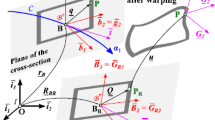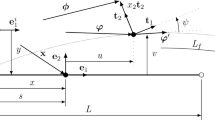Abstract
A convenient “working” model for passive damping in a flexible structure is proportional damping. Strictly proportional damping requires that the damping operator be (essentially) the square root of the stiffness operator. In this paper we present an explicit calculation of the square root for the case of the bending of a uniform Bernoulli beam clamped at one end and subject to control forces and moments at the other end, and we show that nonlocal terms are added in the interior as well as at the ends in contrast to the case where there are no end-masses and both ends are simply supported. We show that if strict proportionality is relaxed to require only asymptotic proportionality, then we can avoid the nonlocal feature although the boundary equations will still need to include additional terms.
Similar content being viewed by others
References
L. W. Taylor and A. V. Balakrishnan. A mathematical problem and a spacecraft control laboratory experiment (SCOLE) used to evaluate control laws for flexible spacecraft, NASA/IEEE design challenge. InProceedings of the NASA SCOLE Workshop. NASA Langley Research Center, December 1984.
A. V. Balakrishnan. A Mathematical Formulation of the SCOLE Control Problem, Part I. NASA CR 172581, May 1985.
A. V. Balakrishnan. Damping operators in continuum models of flexible structures: explicit models for proportional damping in beam torsion.Journal of Differential and Integral Equations, Vol. 3, No. 4 (1990) (to appear).
A. V. Balakrishnan. Fractional powers of closed operators and the semigroups generated by them.Pacific Journal of Mathematics, Vol. 10 (1960), pp. 417–437.
A. V. Balakrishnan. Control of flexible flight structures. InMathematique et Applications. Paris: Gauthier-Villars, 1988, pp. 23–34.
H. Fattorini.The Cauchy Problem. New York: Addison-Wesley, 1983.
L. A. Bergman and J. W. Nicholson. Forced vibration of a damped combined linear system.Journal of Vibration, Acoustics, Stress and Reliability in Design, Vol. 107/275 (1985).
A. V. Balakrishnan. Stability Enhancement of Flexible Structures by Nonlinear Feedback Control.Lecture Notes in Control and Information Sciences, Vol. 100. Berlin: Springer-Verlag, 1987.
S. Chen and R. Triggiani. Proof of extensions of two conjectures on structural damping for elastic systems.Pacific Journal of Mathematics, Vol. 136, No. 1 (1989), pp. 15–55.
Author information
Authors and Affiliations
Additional information
Research supported in part under Grant No. 88-0252, AFOSR, USAF.
Rights and permissions
About this article
Cite this article
Balakrishnan, A.V. Damping operators in continuum models of flexible structures: Explicit models for proportional damping in beam bending with end-bodies. Appl Math Optim 21, 315–334 (1990). https://doi.org/10.1007/BF01445168
Accepted:
Published:
Issue Date:
DOI: https://doi.org/10.1007/BF01445168




